| Revision as of 17:57, 22 December 2012 view source81.174.238.13 (talk) Grammar error.← Previous edit | Revision as of 04:23, 25 December 2012 view source 69.116.243.38 (talk)No edit summaryNext edit → | ||
| Line 7: | Line 7: | ||
| The main point on which the two-state solution formula differs from those for an ] is that it calls for direct negotiations between Israel and the Palestinian Authority. To achieve a two-state solution, a number of core issues must be resolved, including the borders of the Palestinian state, the citizenship of the ], the status of ] outside the final borders, and the status of Arab citizens of present-day Israel, besides the future of East Jerusalem. | The main point on which the two-state solution formula differs from those for an ] is that it calls for direct negotiations between Israel and the Palestinian Authority. To achieve a two-state solution, a number of core issues must be resolved, including the borders of the Palestinian state, the citizenship of the ], the status of ] outside the final borders, and the status of Arab citizens of present-day Israel, besides the future of East Jerusalem. | ||
| Over the years, polls have consistently shown "respectable Israeli and Palestinian majorities in favor of a negotiated two-state settlement."<ref>, Hussein Agha and Robert Malley, '']''. Retrieved Jan. 9, 2009</ref> In a 2007 poll, |
Over the years, polls have consistently shown "respectable Israeli and Palestinian majorities in favor of a negotiated two-state settlement."<ref>, Hussein Agha and Robert Malley, '']''. Retrieved Jan. 9, 2009</ref> In a 2007 poll, almost three quarters of the Palestinian respondents in the West Bank and Gaza Strip approved either a binational or two-state solution; 46% preferred the two-state solution, and 26% preferred the binational solution.<ref name=JMCC-200703>{{citation|url=http://www.jmcc.org/publicpoll/results/2007/no61.pdf|title=On Palestinian attitudes towards the Formation of the National Unity Government|publisher=Jerusalem Media & Communication Centre|id=Poll no. 61, Part One|date=March 2007|accessdate=2008-01-01 |archiveurl = http://web.archive.org/web/20071201142657/http://www.jmcc.org/publicpoll/results/2007/no61.pdf <!-- Bot retrieved archive --> |archivedate = 2007-12-01}}</ref> The two-state solution also enjoys majority support in Israeli polls although there has been some erosion to its prospects over time.<ref name=reut-20070612>{{citation|url=http://www.reut-institute.org/Publication.aspx?PublicationId=1753|title=Is One State Enough?|publisher=Reut Institute|date=12 June 2007|accessdate=2008-01-01}}</ref> | ||
| Another option is the ], which could either be a twin regime federalist arrangement or a unitary state,<ref name=reut-20041101>{{citation|url=http://www.reut-institute.org/Publication.aspx?PublicationId=346|title=One State Threat|publisher=Reut Institute|date=1 November 2004|accessdate=2008-01-01}}</ref> and the ], also known as the "no-state solution." | Another option is the ], which could either be a twin regime federalist arrangement or a unitary state,<ref name=reut-20041101>{{citation|url=http://www.reut-institute.org/Publication.aspx?PublicationId=346|title=One State Threat|publisher=Reut Institute|date=1 November 2004|accessdate=2008-01-01}}</ref> and the ], also known as the "no-state solution." | ||
Revision as of 04:23, 25 December 2012
Not to be confused with Two-Nation Theory.| Part of a series on the Israeli–Palestinian conflict | ||||||||||||||||||||||||||||
| Israeli–Palestinian peace process | ||||||||||||||||||||||||||||
|---|---|---|---|---|---|---|---|---|---|---|---|---|---|---|---|---|---|---|---|---|---|---|---|---|---|---|---|---|
History
|
||||||||||||||||||||||||||||
| Primary concerns | ||||||||||||||||||||||||||||
| Secondary concerns | ||||||||||||||||||||||||||||
| International brokers | ||||||||||||||||||||||||||||
| Proposals | ||||||||||||||||||||||||||||
| Projects / groups / NGOs | ||||||||||||||||||||||||||||

The two-state solution refers to the solution to the Israeli-Palestinian conflict currently under discussion, which calls for "two states for two peoples". The two-state solution envisages the establishment of an independent Palestinian state alongside the State of Israel.
The main point on which the two-state solution formula differs from those for an independent Palestinian state is that it calls for direct negotiations between Israel and the Palestinian Authority. To achieve a two-state solution, a number of core issues must be resolved, including the borders of the Palestinian state, the citizenship of the new Palestinian state, the status of Palestinian refugees outside the final borders, and the status of Arab citizens of present-day Israel, besides the future of East Jerusalem.
Over the years, polls have consistently shown "respectable Israeli and Palestinian majorities in favor of a negotiated two-state settlement." In a 2007 poll, almost three quarters of the Palestinian respondents in the West Bank and Gaza Strip approved either a binational or two-state solution; 46% preferred the two-state solution, and 26% preferred the binational solution. The two-state solution also enjoys majority support in Israeli polls although there has been some erosion to its prospects over time.
Another option is the binational solution, which could either be a twin regime federalist arrangement or a unitary state, and the Allon Plan, also known as the "no-state solution."
History
The first proposal for the creation of Jewish and Arab states in the British Mandate of Palestine was made in the Peel Commission report of 1937, with the Mandate continuing to cover only a small area containing Jerusalem. The proposal was rejected by the Arab community of Palestine; was accepted by most of the Jewish leadership; and the British government rejected partition as impracticable.
Partition was again proposed by the 1947 UN Partition plan for the division of Palestine. It proposed a three-way division, again with Jerusalem held separately, under international control. The partition plan was accepted by the Jewish leadership. However, the plan was rejected by the leadership of Arab nations and the Palestinian leadership at the time, which opposed any partition of Palestine and any Jewish presence in the area. The 1948 Arab-Israeli War for control of the disputed land broke out soon afterwards.
The first indication that the PLO would be willing to accept a two-state solution, on at least an interim basis, was articulated by Said Hammami in the mid-1970s.
Security Council resolutions dating back to June 1976 supporting the two-state solution based on the pre-1967 lines were vetoed by the United States, which argued that the borders must be negotiated directly by the parties. The idea has had overwhelming support in the UN General Assembly since the mid 1970s.
The Palestinian Declaration of Independence of 15 November 1988, which referenced the UN Partition Plan of 1947 and "UN resolutions since 1947" in general, was interpreted as an indirect recognition of the State of Israel, and support for a two-state solution. The Partition Plan was invoked to provide legitimacy to Palestinian statehood. Subsequent clarifications were taken to amount to the first explicit Palestinian recognition of Israel.
Many Palestinians and Israelis, as well as the Arab League, have stated that they would accept a 2-state solution based on 1949 Armistice Agreements. In a 2002 poll conducted by PIPA, 72% of both Palestinians and Israelis supported at that time a peace settlement based on the 1967 borders so long as each group could be reassured that the other side would be cooperative in making the necessary concessions for such a settlement.
However, a strong view is that neither side would be able to agree to a division that yielded the Temple Mount to the other side. As an attempt to break the stalemate, U.S. President Bill Clinton proposed dividing sovereignty of the site vertically - the ground and area below coming under Israeli sovereignty, while that above the ground (i.e. the Haram al-Sharif containing the Dome of the Rock and al-Aqsa Mosque) would be under Palestinian sovereignty. A similar idea was suggested for tunnels and elevated roads connecting communities. In the end neither side accepted the concept.

In the late 1990s, considerable diplomatic work went into negotiating a two-state solution between the parties, beginning with the failed Madrid Conference in 1991. The most significant of these negotiations was the Oslo Accords, which officially divided Palestinian land into three administrative divisions and created the framework for how much of Israel's political borders with the Palestinian territories function today. The Accords culminated in the Camp David 2000 Summit, and follow-up negotiations at Taba in January 2001, but no final agreement was ever reached. The violent outbreak of the Second Intifada in 2000 had demonstrated the Palestinian public's disillusionment with the Oslo Accords and convinced many Israelis that the negotiations were in vain.
Possible two-state solutions have been discussed by Saudi and US leaders. In 2002, Crown Prince (now King) Abdullah of Saudi Arabia proposed the Arab Peace Initiative, which garnered the unanimous support of the Arab League. President Bush announced his support for a Palestinian state, opening the way for United Nations Security Council Resolution 1397, supporting a two-state solution. Christian communities in Israel also back the solution.
In a 2007 poll in the Gaza Strip and the West Bank by the Jerusalem Media & Communication Centre, 46.7% of respondents favored a two-state solution, followed by 26.5% for a binational state. However support is lower among younger Palestinians; U.S. Secretary of State Condoleezza Rice noted: "Increasingly, the Palestinians who talk about a two-state solution are my age."
At the Annapolis Conference in November 2007, three major parties — The PLO, Israel, and The USA — agreed on a two-state solution as the outline for negotiations.
Since entering office, Obama has halted the sale of advanced weapons to Israel while demanding that they withdraw from the entire West Bank so that a Palestinian state could be set up.
On June 4, 2009, US President Barack Obama delivered a major address to the Muslim world in Cairo, Egypt. In the speech, he reiterated US support for the two-state solution:
"For decades, there has been a stalemate: two peoples with legitimate aspirations, each with a painful history that makes compromise elusive. It is easy to point fingers – for Palestinians to point to the displacement brought by Israel’s founding, and for Israelis to point to the constant hostility and attacks throughout its history from within its borders as well as beyond. But if we see this conflict only from one side or the other, then we will be blind to the truth: the only resolution is for the aspirations of both sides to be met through two states, where Israelis and Palestinians each live in peace and security."
On June 14, 2009, Israeli Prime Minister Benjamin Netanyahu gave a speech at Bar Ilan University endorsing the establishment of a Palestinian state west of the Jordan River, a first in his career. He proposed that the state have limited to no control of its own borders, military, airspace, or foreign relations, and that no Palestinians be allowed right of return to property in Israeli territory. Netanyahu also repeatedly called on the Palestinians to recognize Israel as a Jewish state.
In response to American and British criticism of a plan to demolish the Shepherd Hotel in East Jerusalem, Netanyahu publicly stated that "United Jerusalem is the capital of the Jewish people and the State of Israel," and "Israeli sovereignty in the city is indisputable." Palestinian negotiator Saeb Erekat countered that " knows very much that there will never be peace between Palestinians and Israelis without East Jerusalem being the capital of the Palestinian state."
In January 2011, Al-Jazeera began publishing several classified documents revealing that Abbas' government had offered unprecedented concessions of Palestinian land in secret negotiations with Israel. This shook public confidence in the Abbas government and prompted a ransacking of Al-Jazeera's Ramallah offices by pro-Fatah demonstrators.
Facing internal pressure over the Arab Spring and Al-Jazeera's publication of the "Palestine Papers", Abbas announced his intention to approach the United Nations and formally request statehood via a vote in the United Nations General Assembly — a vote he likely could have won due to 129 out of 192 UN Member Nations already partially or fully recognizing the State of Palestine. However the Obama administration openly threatened to veto any attempts at Palestinian statehood brought before the Security Council. Abbas' plan was ultimately scuttled when it became apparent that Palestine would not get the nine Security Council votes needed to bring the matter to a General Assembly vote.
These pressures have also prompted both Fatah and Hamas to try negotiating a reconciliation agreement that would allow for the formation of a unity government. Israel has repeatedly stated that it will not negotiate statehood with a Palestinian government that includes Hamas.
On 19 May 2011, Obama stated that the 1967 borders with mutually agreed upon swaps should be the basis of the final agreement. The EU said that they would back the United States position.
American Israel Public Affairs Committee (AIPAC) Executive Director Howard Kohr replied that an even-handed approach would put Israel at a disadvantage and that it must be the Palestinians who make a positive step forward.
Modern evolution of Palestine 1916–1922 various proposals: Three proposals for the post World War I administration of Palestine. The red line is the "International Administration" proposed in the 1916 Sykes–Picot Agreement, the dashed blue line is the 1919 Zionist Organization proposal at the Paris Peace Conference, and the thin blue line refers to the final borders of the 1923–48 Mandatory Palestine.
1916–1922 various proposals: Three proposals for the post World War I administration of Palestine. The red line is the "International Administration" proposed in the 1916 Sykes–Picot Agreement, the dashed blue line is the 1919 Zionist Organization proposal at the Paris Peace Conference, and the thin blue line refers to the final borders of the 1923–48 Mandatory Palestine. 1937 British proposal: The first official proposal for partition, published in 1937 by the Peel Commission. An ongoing British Mandate was proposed to keep "the sanctity of Jerusalem and Bethlehem", in the form of an enclave from Jerusalem to Jaffa, including Lydda and Ramle.
1937 British proposal: The first official proposal for partition, published in 1937 by the Peel Commission. An ongoing British Mandate was proposed to keep "the sanctity of Jerusalem and Bethlehem", in the form of an enclave from Jerusalem to Jaffa, including Lydda and Ramle.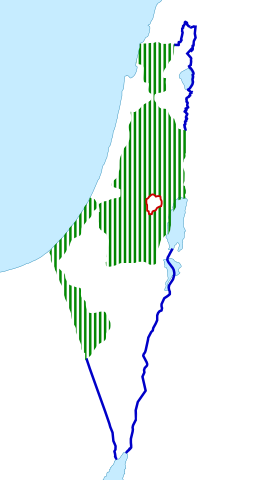 1947 UN proposal: Proposal per the United Nations Partition Plan for Palestine (UN General Assembly Resolution 181 (II), 1947), prior to the 1948 Arab–Israeli War. The proposal included a Corpus Separatum for Jerusalem, extraterritorial crossroads between the non-contiguous areas, and Jaffa as an Arab exclave.
1947 UN proposal: Proposal per the United Nations Partition Plan for Palestine (UN General Assembly Resolution 181 (II), 1947), prior to the 1948 Arab–Israeli War. The proposal included a Corpus Separatum for Jerusalem, extraterritorial crossroads between the non-contiguous areas, and Jaffa as an Arab exclave.
 1947 Jewish private land ownership: Jewish-owned lands in Mandatory Palestine as of 1947 in blue, constituting 7.4% of the total land area, of which more than half was held by the JNF and PICA. White is either public land or Palestinian-Arab-owned lands including related religious trusts.
1947 Jewish private land ownership: Jewish-owned lands in Mandatory Palestine as of 1947 in blue, constituting 7.4% of the total land area, of which more than half was held by the JNF and PICA. White is either public land or Palestinian-Arab-owned lands including related religious trusts.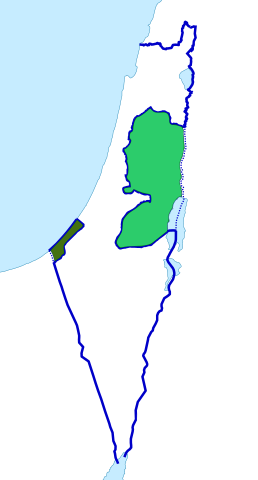 1949 armistice lines: The Jordanian-annexed West Bank (light green) and Egyptian client state All-Palestine Protectorate (dark green), after the 1948 Arab–Israeli War, showing 1949 armistice lines.
1949 armistice lines: The Jordanian-annexed West Bank (light green) and Egyptian client state All-Palestine Protectorate (dark green), after the 1948 Arab–Israeli War, showing 1949 armistice lines.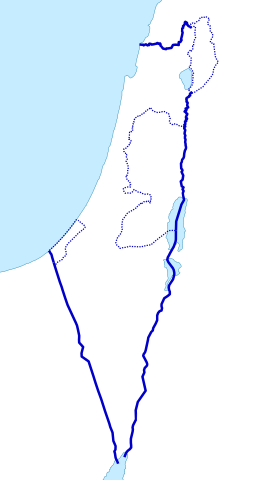 1967 territorial changes: During the Six-Day War, Israel captured the West Bank, the Gaza Strip, and the Golan Heights, together with the Sinai Peninsula (later traded for peace after the Yom Kippur War). In 1980–81 Israel annexed East Jerusalem and the Golan Heights.
Neither Israel's annexation nor the PLO claim over East Jerusalem gained international recognition.
1967 territorial changes: During the Six-Day War, Israel captured the West Bank, the Gaza Strip, and the Golan Heights, together with the Sinai Peninsula (later traded for peace after the Yom Kippur War). In 1980–81 Israel annexed East Jerusalem and the Golan Heights.
Neither Israel's annexation nor the PLO claim over East Jerusalem gained international recognition.
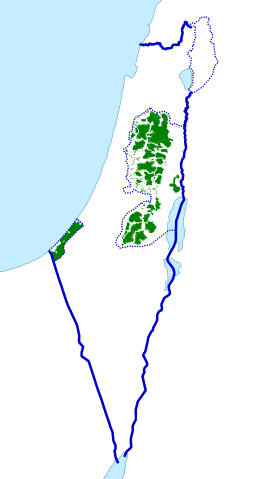 1995 Oslo II Accord: Under the Oslo Accords, the Palestinian National Authority was created to provide a Palestinian interim self-government in the West Bank and the interior of the Gaza Strip. Its second phase envisioned "Palestinian enclaves".
1995 Oslo II Accord: Under the Oslo Accords, the Palestinian National Authority was created to provide a Palestinian interim self-government in the West Bank and the interior of the Gaza Strip. Its second phase envisioned "Palestinian enclaves".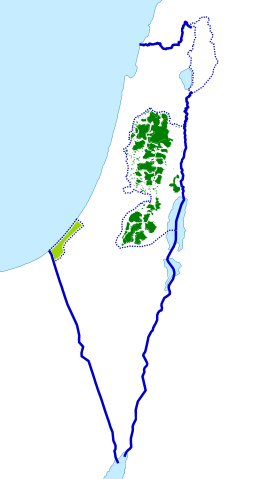 2005–present: After the Israeli disengagement from Gaza and clashes between the two main Palestinian parties following the Hamas electoral victory, two separate executive governments took control in the Palestinian territories of the West Bank and Gaza.
2005–present: After the Israeli disengagement from Gaza and clashes between the two main Palestinian parties following the Hamas electoral victory, two separate executive governments took control in the Palestinian territories of the West Bank and Gaza.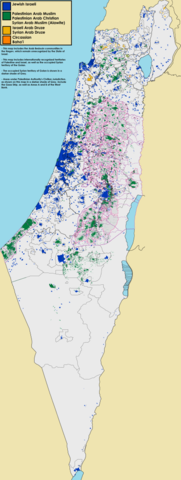 Ethnic majority by settlement (present): The map indicates the ethnic majority of settlements (cities, villages and other communities).
Ethnic majority by settlement (present): The map indicates the ethnic majority of settlements (cities, villages and other communities).
Today
On 28 May 2011, Abbas said that the conditions laid out by Netanyahu had left no foundations for negotiations and that the only remaining option would be recognition of statehood by the United Nations. However Joseph Deiss said that this move could be vetoed at the UN Security Council.
In 2011 Palestinian Prime Minister Salam Fayyad said that if Israel did not cede all the 1967 territories, then the Palestinians would have no alternative to seeking Israeli citizenship. The call for a return to the 1967 lines was echoed by Nabil Shaath.
The New York Times, reported that Egypt and Jordan were concerned about having to retake responsibility for Gaza and the West Bank. In effect, the result would be Gaza returning to Egyptian rule, and the West Bank to Jordanian, referred to as the Three state solution. In a September 2008 publication of the Washington Institute for Near East Policy, Giora Eiland wrote that:
This proposal suggests that rather than establishing another Arab state, the parties could return control over most of the West Bank to Jordan. Until recently, such an idea was rejected completely by everyone, especially the Jordanians themselves. Today, however, more and more Jordanians, Palestinians, and Israelis have come to believe that this is the right solution. The main reason for this change of heart is the rise of Hamas. Israel can curb the group’s ascendancy, but only as long as Israel occupies the West Bank. If a Palestinian state is established there, many fear that it would be taken over by Hamas. Such a scenario could have far-reaching consequences for Jordan. To be sure, the notion of pursuing alternative solutions is not yet politically correct, and therefore no official Jordanian or Palestinian support could be given to such efforts at the moment. Nevertheless, tacit support for this idea has been expressed in private talks.
Some Israeli journalists suggest that the Palestinians are unprepared to accept a Jewish State on any terms. According to one poll, "fewer than 2 in 10 Arabs, both Palestinian and all others, believe in Israel's right to exist as a nation with a Jewish majority." Another poll, however, invoked by the US State Department, suggests that "78 percent of Palestinians and 74 percent of Israelis believe a peace agreement that leads to both states living side by side as good neighbors" is “essential or desirable”.
The Palestinians have "shown serious interest" in a two-state solution since the mid-1970s, and its mainstream leadership has embraced the concept since the 1982 Arab Summit in Fez. However, in March 2009 Mohammad Dahlan of the PLO stated that, “For the 1,000th time, I want to reaffirm that we are not asking Hamas to recognize Israel’s right to exist. Rather we are asking Hamas not to do so, because Fatah never recognized Israel’s right to exist.”
Viability of a Palestinian state
By 2010, when direct talks were scheduled to be restarted, continued growth of settlements on the west bank and continued strong support of settlements by the Israeli government had greatly reduced the land and resources that would be available to a Palestinian state creating doubt among Palestinians and left-wing Israelis that a two-state solution continued to be viable. In 2012 the European Union found that Israel's continuing forced transfer of the Palestinian population was making a two-state solution less likely. The Israeli Foreign Ministry rejected this EU report, claiming it was "based on a partial, biased and one sided depiction of realities on the ground."
On 29 November 2012, the UN General Assembly voted by 138 to 9 to recognize Palestine as a "Non-member observer state". On the following day, Israeli PM Benjamin Netanyahu announced the building of 3,000 new homes on land to the east of East Jerusalem, in an area referred to as "E-1". The move was immediately criticized by several countries, including the United States, with Israeli ambassadors being personally called for meetings with government representatives in the UK, France and Germany, among others. Israel's decision to build the homes was described by the Obama administration as "counterproductive", while Australia said that the building plans "threaten the viability of a two-state solution". This is because the proposed E-1 settlement would physically split the lands under the control of the Palestinian National Authority in two, as the extent of the PNA's authority does not extend all the way to the River Jordan and the Dead Sea.
See also
- State of Judea
- Two Stars for Peace solution
- Arab Peace Initiative
- List of Middle East peace proposals
- United Nations Partition Plan for Palestine
References
- How Not to Make Peace in the Middle East, Hussein Agha and Robert Malley, The New York Review of Books. Retrieved Jan. 9, 2009
- On Palestinian attitudes towards the Formation of the National Unity Government (PDF), Jerusalem Media & Communication Centre, March 2007, Poll no. 61, Part One, archived from the original (PDF) on 2007-12-01, retrieved 2008-01-01
- Is One State Enough?, Reut Institute, 12 June 2007, retrieved 2008-01-01
- One State Threat, Reut Institute, 1 November 2004, retrieved 2008-01-01
- Swedenburg, Ted (1988) The Role of the Palestinian Peasantry in the Great Revolt 1936 - 1939. in Islam, Politics, and Social Movements, edited by Edmund Burke III and Ira Lapidus. Berkeley: University of California Press. ISBN 0-520-06868-8 pp 189-194 & Marvin E. Gettleman, Stuart Schaar (2003) The Middle East and Islamic world reader, Grove Press, ISBN 0-8021-3936-1 pp 177-181
- Pappé Ilan (2004) A history of modern Palestine: one land, two peoples, Cambridge University Press, ISBN 0-521-55632-5
- "Appendix IV: Palestine: Historical Background" Jewish Virtual Library. "The British Government accompanied the publication of the Woodhead Report by a statement of policy rejecting partition as impracticable in the light of the Commission's investigations, but suggesting that Arab-Jewish agreement might still be possible."
- Ayoob, Mohammed. The Middle East in world politics. 1981, page 90
- Ḥusayn Āghā, Shai Feldman, Aḥmad Khālidī, Zeev Schiff. Track-II diplomacy: lessons from the Middle East. 2003, page 11
- Cattan, Henry. The Palestine question. 1988, page 307
- Committee on the Exercise of the Inalienable Rights of the Palestinian People
- The Beirut Declaration: 2002 Arab League Peace Initiative (Full Text)
- Large Israeli and Palestinian Majorities Indicate Readiness for Two-State Solution Based on 1967 Borders
- Beyond a two-state solution
- Frontline: House of Saud
- US Depart of State - UN Security Council Resolution 1397
- Palestinians Voice Support for Two-State Solution
- Richard Boudreaux and Ashraf Khalil (May 14, 2008). "Can 2 foes live under 1 roof?". Chicago Tribune. Retrieved 2008-06-17.
- Obama rejected Netanyahu request for F-15E in 'tough' session
- http://www.whitehouse.gov/the_press_office/Remarks-by-the-President-at-Cairo-University-6-04-09/
- http://www.haaretz.com/news/full-text-of-netanyahu-s-foreign-policy-speech-at-bar-ilan-1.277922
- Israel Rejects US Demand to Halt East Jerusalem Project
- http://www.maannews.net/eng/ViewDetails.aspx?ID=353874
- Issacharoff, Avi. "Palestinians to ask for UN recognition if peace talks fail, says Abbas." Haaretz Newspaper, 31 March 2011.
- Spillius, Alex (22 September 2011). "Barack Obama tells Mahmoud Abbas US will veto Palestinian statehood bid". The Daily Telegraph. London.
- McGreal, Chris (11 November 2011). "UN vote on Palestinian state put off amid lack of support". The Guardian. London.
- Bronner, Ethan. "As Obama Endorses ’67 Borders, Netanyahu Objects." New York Time, 19 May 2011.
- "EU backs Obama's call for Mideast peace treaty based on 1967 borders." AP, 23 May 2011.
- Mozgovaya, Natasha. "AIPAC chief: Obama should not be even-handed toward Israel and Palestinians." Haaretz Newspaper, 23 May 2011.
- "Abbas: No hope for peace talks, only option is UN recognition of statehood." Reuters, 28 May 2011.
- "Palestinian state requires UN council support." AP, 28 May 2011.
- Mozgovaya, Natasha. "Palestinian PM Fayyad: Time is not right for serious peace talks." Haaretz Newspaper, 20 October 2011.
- "Palestinian negotiator: Israel must agree to our terms, or no peace talks." Haaretz Newspaper, 26 October 2011.
- Slackman, Michael (January 12, 2009). "Crisis Imperils 2-State Plan, Shifting a Balance". The New York Times. Retrieved March 28, 2010.
- http://www.haaretz.com/hasen/pages/rosnerBlog.jhtml?itemNo=877534&contrassID=25&subContrassID=0&sbSubContrassID=1&listSrc=Y&art=1
- http://www.washingtoninstitute.org/download.php?file=PolicyFocus88.pdf page xii
- ^ No Common Ground,By JEFFREY GOLDBERG, New York Times, May 20, 2009,http://www.nytimes.com/2009/05/24/books/review/Goldberg-t.html?_r=1&ref=books
- The No-State Solution ; Hamas cares more about Shariah than 'Palestine,' Wall Street Journal, JANUARY 13, 2009
- BLANKLEY: The two-state 'solution' mirage, Time for reality-based diplomacy on Israel and Palestinians, Tony Blankley | Tuesday, May 19, 2009
- http://www.america.gov/st/mena-english/2009/July/200907021105032SAdemahoM0.6612164.html
- Mark A. Tessler. A History of the Israeli-Palestinian conflict. 1994, page 718
- "In Mideast Talks, Scant Hopes From the Beginning" news analysis by Ethan Bronner in The New York Times August 20, 2010, accessed August 21, 2010
- Hass, Amira. "EU report: Israel policy in West Bank endangers two-state solution." Haaretz Newspaper, 12 January 2012.
- Ravid, Barak. "EU: Israel's policies in the West Bank endanger two-state solution." Haaretz Newspaper, 14 May 2012.
- Israel Plans To Expand Settlements In East Jerusalem, West Bank NPR, 30 Nov 2012. Retrieved 5 Dec 2012.
- Israel takes a harder line, LA Times, 4 Dec 2012. Retrieved 5 Dec 2012.
- Australia joins countries criticizing settlements, Jerusalem Post, 4 Dec 2012. Retrieved 5 Dec 2012.
- Israel responds to UN vote by building more homes, Jewish News One (YouTube), 3 Dec 2012. Retrieved 5 Dec 2012.
- Israel to advance East Jerusalem building plans, USA Today, 4 Dec 2012. Retrieved 5 Dec 2012.
- Explaining Israel’s Reaction to the U.N.’s pro-Palestinian Vote, The Daily Beast/Newsweek, 3 Dec 2012. Retrieved 5 Dec 2012.
Further reading
- Aharon Cohen, Israel and the Arab World (Funk and Wagnalls, New York, 1970)
- Jeremy Pressman, "The Best Hope - Still?" Boston Review, July/August 2009.
External links
- The Future of the TwoState Solution, Giora Eiland, Jerusalem Center for Public Affairs, February 2009
- Two-state solution-discredited - without workable alternative, Beate Zilversmidt, The Other Israel, May 2006
- "Two-State Chimera, No-State Solution". Why there won't ever be two 'states'. Cameron Hunt, Counter Currents, May 2007
- "Banging Square Pegs into Round Holes," Dore Gold, ed. David Pollack, Washington Institute for Near East Policy, December 2008
- "The Middle East conflict and the two-state solution," RearVision, ABC Radio National, September 23, 2009
- Taking the two-state solution seriously, Opinion by Alain Dieckhoff, March 2009, European Union Institute for Security Studies
- A Demilitarized Palestinian State, On the meaning of that & summary of security arrangement out of previous Israeli-Palestinian accords, Reut Institution (a Think Tank)
- "The Four Two-State Solutions," June 17, 2011